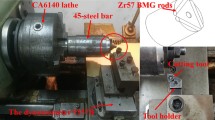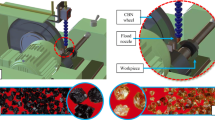Abstract
There are limited studies in the literature about machinability of bulk metallic glass (BMG). As a novel and promising structural material, BMG material machining characteristics need to be verified before its utilization. In this paper, the effects of cutting speed, feed rate, depth of cut, abrasive particle size/type on the BMG grinding in dry conditions were experimentally investigated. The experimental evaluations were carried out using cubic boron nitride (CBN) and Al2O3 cup wheel grinding tools. The parameters were evaluated along with the results of cutting force, temperature and surface roughness measurements, X-ray, scanning electron microscope (SEM) and surface roughness analyse. The results demonstrated that the grinding forces reduced with the increasing cutting speed as specific grinding energy increased. The effect of feed rate was opposite to the cutting speed effect, and increasing feed rate caused higher grinding forces and substantially lower specific energy. Some voids like cracks parallel to the grinding direction were observed at the edge of the grinding tracks. The present investigations on ground surface and grinding chips morphologies showed that material removal and surface formation of the BMG were mainly due to the ductile chip formation and ploughing as well as brittle fracture of some particles from the edge of the tracks. The roughness values obtained with the CBN wheels were found to be acceptable for the grinding operation of the structural materials and were in the range of 0.34–0.58 μm. This study also demonstrates that conventional Al2O3 wheel is not suitable for grinding of the BMG in dry conditions.











Similar content being viewed by others
References
Inoue A, Zhang T, Masumoto T (1989) Al-La-Ni amorphous alloys with a wide supercooled liquid region. Mater Trans JIM 30:965–972
Inoue A, Kato A, Zhang T et al (1991) Mg-Cu-Y amorphous alloys with high mechanical strengths produced by a metallic mold casting method. Mater Trans JIM 32:609–616
Zhang T, Inoue A, Masumoto T (1991) Amorphous Zr-Al-Tm (Tm = Co, Ni, Cu) alloys with significant supercooled liquid region of over 100 K. Mater Trans JIM 32:1005–1010
Peker A, Johnson WL (1993) A highly processable metallic glass: Zr41.2Ti13.8Cu12.5Ni10.0Be22.5. Appl Phys Lett 63:2342–2344
Liu CT, Heatherly L, Easton DS et al (1998) Test environment and mechanical properties of Zr-based bulk amorphous alloys. Metall Mater Trans A 29A:1811–1920
Nieh TG, Schuh C, Wadsworth J et al (2002) Strain rate-dependent deformation in bulk metallic glasses. Intermetallics 10:1177–1182
Bakkal M, Shih AJ, Scattergood RO (2004) Machining of a Zr-Ti-Al-Cu-Ni metallic glass. Scr Mater 50:583–588
Bakkal M, McSpadden SB, Liu CT et al (2005) Light emission, chip morphology, and burr formation in drilling of bulk metallic glass. Int J Mach Tools Manuf 45:741–752
Han DX, Wang G, Li J et al (2015) Cutting characteristics of Zr-based bulk metallic glass. J Mater Sci Technol 31(2):153–158
Sun Y, Huang Y, Fan H et al (2014) Comparison of mechanical behaviors of several bulk metallic glasses for biomedical application. J Non-Cryst Solids 406:144–150
Bakkal M, Liu CT, Watkins TR et al (2004) Oxidation and crystallization of Zr-based bulk metallic glass due to machining. Intermetallics 12:195–204
Bakkal M, Shih AJ, Scattergood RO (2004) Chip formation, cutting forces, and tool wear in turning of Zr-based bulk metallic glass. Int J Mach Tools Manuf 44:915–925
Bakkal M, Shih AJ, McSpadden SB et al (2005) Thrust Force, torque, and tool wear in drilling of bulk metallic glass. Int J Mach Tools Manuf 45:863–872
Malkin S, Guo C (2008) Grinding technology: theory and applications of machining with abrasives. Industrial Press, New York
Xu X, Malkin S (2001) Comparison of methods to measure grinding temperature. Trans ASME J Manuf Sci Eng 123:191–196
Shen B, Xiao GX, Guo CS et al (2008) Thermocouple fixation method for grinding temperature measurement. J Manuf Sci Eng 130:051014
Chen X, Rowe WB, Cai R (2002) Precision grinding using CBN wheels. Int J Mach Tools Manuf 42:585–593
Malkin S (1976) Selecting of operating parameters in surface grinding of steels. J Eng Ind 98:56–62
Marinescu ID, Hitchiner M, Ulhmann E et al (2007) Handbook of machining with grinding wheels. CRC Press, Boca Raton
Malkin S, Cook NH (1971) The wear of grinding wheels, Part 1, attritious wear. J Eng Ind 93:1120–1129
Fu XY, Falk ML, Rigney DA (2001) Sliding behavior of metallic glass Part I: experimental investigations. Wear 250:409–419
Prakash B (2005) Abrasive wear behaviour of Fe, Co, and Ni based metallic glasses. Wear 258:217–224
Acknowledgment
A portion of this research was sponsored by The Scientific and Technological Research Council of Turkey (TUBITAK) under the project number 107M443 and Istanbul Technical University Research Foundation (ITU-BAP project).
Author information
Authors and Affiliations
Corresponding author
Rights and permissions
About this article
Cite this article
Bakkal, M., Serbest, E., Karipçin, İ. et al. An experimental study on grinding of Zr-based bulk metallic glass. Adv. Manuf. 3, 282–291 (2015). https://doi.org/10.1007/s40436-015-0121-6
Received:
Accepted:
Published:
Issue Date:
DOI: https://doi.org/10.1007/s40436-015-0121-6




